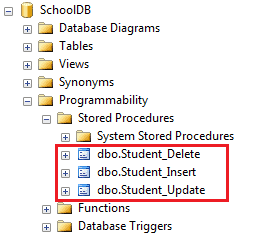Entity Framework 6 Code-First provides the ability to create and use a stored procedure for add, update, and delete operations when the SaveChanges() method is called.
Let's use stored procedures for the CUD (Create, Update, Delete) operations for the following
Student entity.class Student { public int StudentId { get; set; } public string StudentName { get; set; } public DateTime DoB { get; set; } }
Use the
MapToStoredProcedures() method to map an entity with the default stored procedures (these default stored procedures will be created by EF API). The following example maps the Student entity with the default stored procedures.public class SchoolContext: DbContext { protected override void OnModelCreating(DbModelBuilder modelBuilder) { modelBuilder.Entity<Student>() .MapToStoredProcedures(); } public DbSet<Student> Students { get; set; } }
EF API will create three procedures
Student_Insert, Student_Update and Student_Delete for the above Student entity, as shown below.
The
Student_Insert and Student_Update stored procedures include parameters for all the properties of the Student entity. The Student_Delete procedure includes a parameter only for the primary key property StudentId of the Student entity. The following is a stored procedures script.CREATE PROCEDURE [dbo].[Student_Insert] @StudentName [nvarchar](max), @DoB [datetime] AS BEGIN INSERT [dbo].[Students]([StudentName], [DoB]) VALUES (@StudentName, @DoB) DECLARE @StudentId int SELECT @StudentId = [StudentId] FROM [dbo].[Students] WHERE @@ROWCOUNT > 0 AND [StudentId] = scope_identity() SELECT t0.[StudentId] FROM [dbo].[Students] AS t0 WHERE @@ROWCOUNT > 0 AND t0.[StudentId] = @StudentId END CREATE PROCEDURE [dbo].[Student_Update] @StudentId [int], @StudentName [nvarchar](max), @DoB [datetime] AS BEGIN UPDATE [dbo].[Students] SET [StudentName] = @StudentName, [DoB] = @DoB WHERE ([StudentId] = @StudentId) END CREATE PROCEDURE [dbo].[Student_Delete] @StudentId [int] AS BEGIN DELETE [dbo].[Students] WHERE ([StudentId] = @StudentId) END
Map Custom Stored Procedures to an Entity
EF 6 allows you to use your own custom stored procedures and map them to an entity. You can also configure parameters mapping with entity properties.
The following example maps custom stored procedures with the
Student entity.protected override void OnModelCreating(DbModelBuilder modelBuilder) { modelBuilder.Entity<Student>() .MapToStoredProcedures(p => p.Insert(sp => sp.HasName("sp_InsertStudent").Parameter(pm => pm.StudentName, "name").Result(rs => rs.StudentId, "Id")) .Update(sp => sp.HasName("sp_UpdateStudent").Parameter(pm => pm.StudentName, "name")) .Delete(sp => sp.HasName("sp_DeleteStudent").Parameter(pm => pm.StudentId, "Id")) ); }
In the above example, the
Student entity is mapped to sp_InsertStudent, sp_UpdateStudent and sp_DeleteStudent stored procedures. It also configures mapping between parameters and entity properties.Use Stored Procedures for All Entities
You can map all your entities with the default stored procedures in a single statement as shown below.
protected override void OnModelCreating(DbModelBuilder modelBuilder) { modelBuilder.Types().Configure(t => t.MapToStoredProcedures()); }
Limitations
- Only Fluent API can be used to map stored procedures. No data annotation attributes are available in EF 6 for stored procedure mapping.
- You must map insert, update and delete stored procedures to an entity if you want to use stored procedure for CUD operations. Mapping only one of them is not allowed.





0 comments:
Post a Comment
Note: only a member of this blog may post a comment.